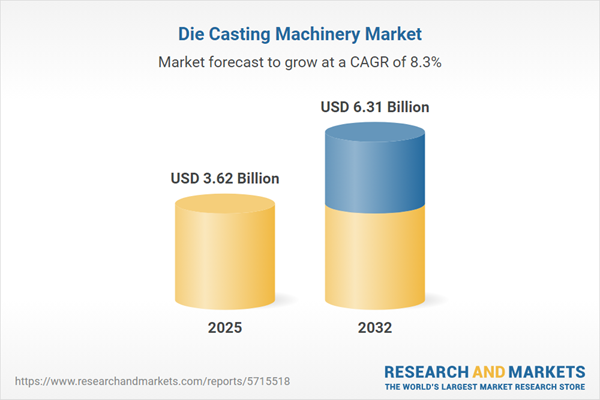Speak directly to the analyst to clarify any post sales queries you may have.
The die casting machinery market is transforming as senior decision-makers pursue operational agility, resilience, and compliance amid growing automation and changing global standards. Competitive advantage today relies on future-ready strategies that respond quickly to evolving industry expectations.
Market Snapshot: Die Casting Machinery Market Growth and Outlook
The global die casting machinery market is forecast to advance from USD 3.34 billion in 2024 to USD 3.62 billion in 2025, with projections reaching USD 6.31 billion by 2032. Major drivers include greater adoption of automation, stringent compliance requirements, and demand from key sectors such as automotive, aerospace, and industrial equipment. To stay competitive, industry leaders increasingly opt for digital connectivity, scalable system architectures, and compliance-driven solutions. These preferences are shaping the adoption of innovative processes, particularly as growing downstream applications redefine value creation across the machinery value chain.
Scope & Segmentation
- End Use Industries: Aerospace, defense, automotive (including body, engines, and transmissions), industrial equipment, and consumer electronics each require distinct levels of machinery performance, addressing priorities from production precision to speed and durability.
- Metal Types: Aluminum, copper, magnesium, and zinc remain essential for their ability to deliver lightweight and regulation-compliant parts. Their properties streamline subsequent manufacturing steps while addressing sector-specific quality benchmarks.
- Machine Types: Cold chamber and hot chamber die casting machines serve differing project needs, offering flexibility to match specific process and material requirements. This adaptability is integral to balancing cost, output, and product integrity.
- Technologies: Counter pressure, low pressure, squeeze, and vacuum casting technologies enable stable performance, excellent part accuracy, and efficient use of materials. Such advancements are meeting demand for complex components and more sustainable production practices.
- Clamping Force Ranges: Machines vary from less than 200 to more than 1000 tons of clamping force, accommodating a wide array of component sizes, material types, and production complexities. This diversity helps suppliers cater to a broad set of industries.
- Regional Coverage: Americas, EMEA (including the UK, Germany, Middle East, and Africa), and Asia-Pacific (with key countries such as China, India, Japan, and Australia) influence technology adoption and business models, as local regulations and economic conditions shape investment and compliance strategies.
- Company Profiles: Industry leaders such as Bühler AG, Italpresse Gauss S.p.A., IDRA S.r.l., Frech Gruppe GmbH & Co. KG, Shibaura Machine Co., Yizumi (Guangdong) Machinery Co., Tederic Machinery Co., LK Machinery, Ningbo Jifeng Precision, and Dongguan Dagong Precision drive progress through strategic supply agreements and continuous technological advancement.
Key Takeaways for Senior Decision-Makers
- Rising complexity in industrial production requires machinery with advanced precision and adaptability across diverse applications.
- Prioritizing automation and integrated sensor technology leads to more effective predictive maintenance and greater production reliability through continuous system monitoring.
- Evolving environmental regulations heighten the need for energy-efficient machines, improved cooling systems, and next-generation lubricants, helping ensure compliance and operational readiness.
- Customizing equipment and workflows for specific regional compliance landscapes reduces exposure to supply chain disruptions and legal uncertainties.
- Close cooperation with suppliers and technology partners provides a pathway to innovative solutions and strengthens preparation for shifting market and regulatory demands.
Tariff Impact: Navigating Shifting Trade Barriers
Recent tariffs on primary metals such as aluminum and magnesium have introduced new cost and sourcing challenges for manufacturers. In response, companies are diversifying suppliers, fostering local sourcing relationships, and evaluating alternative alloys to reduce risk. The adoption of modular industrial systems has added greater flexibility and helped reinforce the resilience of supply chains. Proactive monitoring of trade policies is increasingly important for mitigating operational risks and maintaining production continuity.
Methodology & Data Sources
This analysis synthesizes secondary research—including technical publications, regulatory filings, and industry sources—supplemented by expert interviews with manufacturers, foundries, and major suppliers. These steps ensure the findings deliver current, actionable insights that inform decision-making at the executive level.
Why This Report Matters
- Offers actionable intelligence on die casting machinery market trends, shifts in regulatory compliance, and regional market nuances to support C-suite decision-making.
- Empowers leadership teams with reliable guidance for strategic planning as customer expectations, operational risks, and business priorities evolve globally.
- Supports informed investment and partnership strategies through clear benchmarking of technologies and competitor activity unique to the die casting sector.
Conclusion
The die casting machinery sector is evolving rapidly as technology, regulatory requirements, and global trading dynamics reshape industry priorities. Success will depend on decisive strategic investment, flexible operations, and proactive adaptation to emerging challenges.
Additional Product Information:
- Purchase of this report includes 1 year online access with quarterly updates.
- This report can be updated on request. Please contact our Customer Experience team using the Ask a Question widget on our website.
Table of Contents
3. Executive Summary
4. Market Overview
7. Cumulative Impact of Artificial Intelligence 2025
List of Figures
Samples

LOADING...
Companies Mentioned
The key companies profiled in this Die Casting Machinery market report include:- Bühler AG
- Italpresse Gauss S.p.A.
- IDRA S.r.l.
- Frech Gruppe GmbH & Co. KG
- Shibaura Machine Co., Ltd.
- Yizumi (Guangdong) Machinery Co., Ltd.
- Tederic Machinery Co., Ltd.
- LK Machinery Co., Ltd.
- Ningbo Jifeng Precision Machinery Co., Ltd.
- Dongguan Dagong Precision Machinery Co., Ltd.
Table Information
| Report Attribute | Details |
|---|---|
| No. of Pages | 195 |
| Published | October 2025 |
| Forecast Period | 2025 - 2032 |
| Estimated Market Value ( USD | $ 3.62 Billion |
| Forecasted Market Value ( USD | $ 6.31 Billion |
| Compound Annual Growth Rate | 8.2% |
| Regions Covered | Global |
| No. of Companies Mentioned | 11 |









